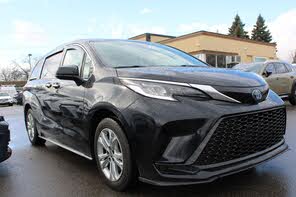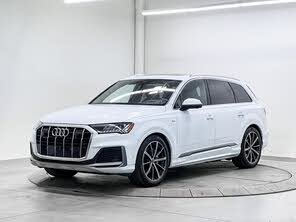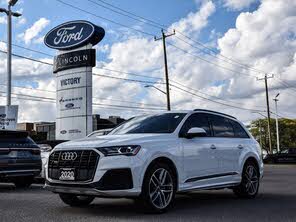2021 Toyota Sienna vs 2020 Audi Q7
Overview | |
MSRP$54,800 | MSRP$34,460 |
Listings14 | Listings84 |
Ratings & Reviews | |
User Reviews | User Reviews |
Expert reviews7.7 out of 10 | Expert reviews8.3 out of 10 |
Pros
Cons
| |
2020 Audi Q7 Reviews SummaryFrom its styling and interior to its powertrain and technology, the 2020 Audi Q7 gets a thorough update that brings it in line with other high-end cars and SUVs wearing four chrome rings on their grilles. Simultaneously, the changes for the 2020 model year keep this Audi competitive against the BMW X5 and Mercedes-Benz GLE-Class, its primary rivals in the midsize luxury SUV class. We packed a Q7 Technik full of family and luggage and set off to assess this Audi’s improvements on the open road. | |
2021 Toyota Sienna Reviews SummaryToyota’s minivan got a major makeover for 2021, now entering its fourth generation of production since debuting as a 1997 model. For the first time, the Sienna gets a hybrid gasoline-electric powertrain, and not only that—it’s standard equipment. The Sienna Hybrid is built on the Toyota New Global Architecture (TNGA-K) platform, shared with the Highlander and other current Toyota models. | |
No video found | |
Popular Features & Specs | |
Engine2.0L 248 hp I4 | Engine2.5L 245 hp I4 Hybrid |
Drive TrainAWD | Drive TrainFWD |
Seating Capacity7 | Seating Capacity8 |
Horsepower248 hp @ 5000 rpm | Horsepower |
EV Battery Capacity | EV Battery Capacity1.9 kWh |
MPG City19 | MPG City36 |
MPG Highway23 | MPG Highway36 |
Engine | |
Engine Name2.0L 248 hp I4 | Engine Name2.5L 245 hp I4 Hybrid |
Torque273 lb-ft @ 1600 rpm | Torque |
Horsepower248 hp @ 5000 rpm | Horsepower |
DrivetrainAWD | DrivetrainFWD |
Fuel Economy | |
EV Battery Capacity | EV Battery Capacity1.9 kWh |
MPG City19 | MPG City36 |
MPG Highway23 | MPG Highway36 |
Interior | |
Leather SeatsStandard | Leather Seats |
Seating Capacity7 | Seating Capacity8 |
Key Features | |
Navigation SystemStandard | Navigation System |
Sunroof/MoonroofStandard | Sunroof/Moonroof |
Safety | |
Front Crash Overall | Front Crash Overall4 |
Side Crash Overall5 | Side Crash Overall5 |
Dimensions & Capacity | |
Cargo Space14.2 cu ft | Cargo Space33.5 cu ft |
Curb Weight4784 lbs | Curb Weight4610 lbs |
Height68.5 in | Height68.5 in |
Length199.6 in | Length203.7 in |
Width87.1 in | Width78.5 in |
Wheelbase117.9 in | Wheelbase120.5 in |
Maximum Payload1367 lbs | Maximum Payload1560 lbs |
Number of doors4 | Number of doors4 |
Maximum Towing Capacity4400 lbs | Maximum Towing Capacity3500 lbs |
Overview | ||
MSRP | $54,800 | $34,460 |
Listings | ||
Ratings & Reviews | ||
User reviews | ||
Expert reviews | 7.7 out of 10Read full review | 8.3 out of 10Read full review |
Pros & cons | Pros
Cons
| |
Summary | From its styling and interior to its powertrain and technology, the 2020 Audi Q7 gets a thorough update that brings it in line with other high-end cars and SUVs wearing four chrome rings on their grilles. Simultaneously, the changes for the 2020 model year keep this Audi competitive against the BMW X5 and Mercedes-Benz GLE-Class, its primary rivals in the midsize luxury SUV class. We packed a Q7 Technik full of family and luggage and set off to assess this Audi’s improvements on the open road. | Toyota’s minivan got a major makeover for 2021, now entering its fourth generation of production since debuting as a 1997 model. For the first time, the Sienna gets a hybrid gasoline-electric powertrain, and not only that—it’s standard equipment. The Sienna Hybrid is built on the Toyota New Global Architecture (TNGA-K) platform, shared with the Highlander and other current Toyota models. |
Video | No video found | |
Popular Features & Specs | ||
Engine | 2.0L 248 hp I4 | 2.5L 245 hp I4 Hybrid |
Drive Train | AWD | FWD |
Seating Capacity | 7 | 8 |
Horsepower | 248 hp @ 5000 rpm | |
EV Battery Capacity | 1.9 kWh | |
MPG City | 19 | 36 |
MPG Highway | 23 | 36 |
Engine | ||
Engine Name | 2.0L 248 hp I4 | 2.5L 245 hp I4 Hybrid |
Torque | 273 lb-ft @ 1600 rpm | |
Horsepower | 248 hp @ 5000 rpm | |
Drivetrain | AWD | FWD |
Fuel Economy | ||
EV Battery Capacity | 1.9 kWh | |
MPG City | 19 | 36 |
MPG Highway | 23 | 36 |
Interior | ||
Leather Seats | Standard | |
Seating Capacity | 7 | 8 |
Key Features | ||
Navigation System | Standard | |
Sunroof/Moonroof | Standard | |
Safety | ||
Front Crash Overall | 4 | |
Side Crash Overall | 5 | 5 |
Dimensions & Capacity | ||
Cargo Space | 14.2 cu ft | 33.5 cu ft |
Curb Weight | 4784 lbs | 4610 lbs |
Height | 68.5 in | 68.5 in |
Length | 199.6 in | 203.7 in |
Width | 87.1 in | 78.5 in |
Wheelbase | 117.9 in | 120.5 in |
Maximum Payload | 1367 lbs | 1560 lbs |
Number of doors | 4 | 4 |
Maximum Towing Capacity | 4400 lbs | 3500 lbs |
The 2020 Audi Q7 presented a refined and modern aesthetic, with its updated front and rear styling aligning it with the flagship Q8 model. The Q7 55 TFSI, priced at $86,100 with the Technik trim, featured 21-inch wheels and a high-tech interior. The cabin, adorned in Okapi Brown leather and Gray/Brown Fine Grain Ash wood inlays, exuded luxury. The dashboard adopted the Q8's digital displays, replacing most physical controls with three screens, including Audi’s Virtual Cockpit. The ambient lighting added a soothing atmosphere, enhancing the upscale and high-tech feel of the vehicle.
In contrast, the 2021 Toyota Sienna aimed to redefine minivan aesthetics with SUV-like styling. Its wide grille and LED headlamp arrays contributed to a sleek, assertive stance. The redesigned sliding side doors and various alloy wheel options enhanced its visual appeal. Inside, the Sienna emphasized width with horizontal lines, offering a higher seating position than a sedan. The dashboard was simple, with controls clustered below the infotainment screen. The centre console featured practical storage solutions, and the second and third-row seats provided comfort and flexibility, accommodating adults with ease.


















The 2020 Audi Q7 55 TFSI was equipped with a new 3.0-litre turbocharged V6 engine, producing 335 horsepower and 369 pound-feet of torque. This engine, paired with a 48-volt mild-hybrid system, improved fuel efficiency by reducing the load on the engine. The eight-speed automatic transmission and Quattro all-wheel-drive system offered multiple driving modes, including Comfort, Auto, Dynamic, Individual, and Allroad. The Q7 accelerated from zero to 100 km/h in 5.9 seconds and had a towing capacity of nearly 3,500 kilograms. Fuel consumption was rated at 12.0 L/100 km combined, with real-world testing showing 11.2 L/100 km. The adaptive air suspension and all-wheel steering enhanced agility and comfort, while the cabin remained remarkably quiet.
The 2021 Toyota Sienna Hybrid featured a 2.5-litre four-cylinder engine and two electric motors, delivering 243 horsepower. The Sienna offered both front-wheel and all-wheel drive, with the latter using a separate electric motor for the rear wheels. The electronically controlled CVT aimed to maximize fuel efficiency, though it sometimes dulled throttle response. The Sienna's handling improved with new suspension systems, providing a comfortable ride. Fuel efficiency was a highlight, with FWD models rated at 6.6 L/100 km city and 6.5 L/100 km highway, while AWD models achieved 6.8 L/100 km city and 6.6 L/100 km highway.
The 2020 Audi Q7, while offering three rows of seats, was best suited for five passengers. The third-row seat was cramped and reduced cargo space to 402 litres when in use. Folding it down expanded cargo capacity to 1,010 litres, and with both rows folded, it reached 1,970 litres. The Q7 provided comfort for a family of four, with power-adjustable, heated, and ventilated front seats. The second row offered ample legroom and climate control features. However, interior storage was limited, with the centre console and dashboard screen occupying most available space.
The 2021 Toyota Sienna excelled in convenience and flexibility. Its third-row 60/40-split bench folded into the floor, while the second row slid up to 63.5 centimetres, facilitating access and legroom adjustments. The cabin boasted 16 cupholders and ample storage cubbies. The Sienna could carry a full four-by-eight sheet of plywood, with cargo space ranging from 949 litres behind the third row to 2,860 litres behind the first row. The hybrid battery was cleverly positioned under the front seats, preserving cargo space. Power-operated sliding doors and liftgate added to its family-friendly features.
The 2020 Audi Q7 introduced MMI Touch Response technology, featuring a 10.1-inch upper touchscreen and an 8.6-inch lower touchscreen. The system included voice and handwriting recognition, wireless Apple CarPlay, navigation, and Audi Connect services. While intuitive, the touchscreens sometimes required multiple attempts due to dry fingertips. The Technik trim offered a head-up display and a Bose sound system, though polarized sunglasses rendered the display invisible.
The 2021 Toyota Sienna came with a nine-inch touchscreen, standard Apple CarPlay and Android Auto, and multiple USB ports. Connectivity features included Safety Connect, Remote Connect, and Service Connect. Higher trims offered Qi-compatible charging and a 1500-watt inverter. Audio systems ranged from a six-speaker setup to a 12-speaker JBL package. A rear-seat entertainment system with an 11.6-inch display was available, and the driver enjoyed a multi-information display and digital rearview mirror.
The 2020 Audi Q7 featured HD Matrix LED headlights, though rated "poor" by the IIHS for glare. It included advanced driving-assistance systems like Emergency Assist, Turn Assist, and Adaptive Cruise Assist. However, the traffic-sign-recognition system occasionally misread signs, leading to unexpected braking. The Q7 received high collision protection ratings from the IIHS, except for the headlights.
The 2021 Toyota Sienna boasted Toyota Safety Sense 2.0, with adaptive cruise control, lane-tracing assist, and pre-collision detection. The Star Safety System and blind spot monitoring were standard, along with 10 airbags and LATCH connectors. The Sienna earned a "Top Safety Pick+" from the IIHS and a Five-Star Overall Rating from NHTSA.
CarGurus highlights

According to CarGurus experts, the overall rating for the 2020 Audi Q7 is 7.7 out of 10, while the 2021 Toyota Sienna scores 8.3 out of 10. Based on these ratings, the 2021 Toyota Sienna is the recommended choice, offering superior practicality, fuel efficiency, and safety features for families.
Choose the 2021 Toyota Sienna if:
- You require a versatile and spacious family vehicle with excellent cargo capacity.
- You want a fuel-efficient hybrid powertrain with advanced safety features.
- You appreciate practical technology and convenience features for family use.
Choose the 2020 Audi Q7 if:
- You prioritize luxury and high-tech features in a vehicle.
- You need a powerful engine with significant towing capacity.
- You value a quiet and comfortable ride with advanced suspension options.
CarGurus highlights

According to CarGurus experts, the overall rating for the 2020 Audi Q7 is 7.7 out of 10, while the 2021 Toyota Sienna scores 8.3 out of 10. Based on these ratings, the 2021 Toyota Sienna is the recommended choice, offering superior practicality, fuel efficiency, and safety features for families.
Choose the 2021 Toyota Sienna if:
Shop Now- You require a versatile and spacious family vehicle with excellent cargo capacity.
- You want a fuel-efficient hybrid powertrain with advanced safety features.
- You appreciate practical technology and convenience features for family use.
Choose the 2020 Audi Q7 if:
Shop Now- You prioritize luxury and high-tech features in a vehicle.
- You need a powerful engine with significant towing capacity.
- You value a quiet and comfortable ride with advanced suspension options.

By: CarGurus + AI
At CarGurus, our team of experienced automotive writers remain at the heart of our content operation, conducting hands-on car tests and writing insightful guides that are backed by years of industry experience. To complement this, we are harnessing AI to make our content offering more diverse and more helpful to shoppers than ever. To achieve this, our AI systems are based exclusively on CarGurus content, ratings and data, so that what we produce is both unique to CarGurus, and uniquely helpful to car shoppers.








































